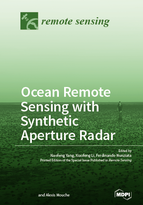Ocean Remote Sensing with Synthetic Aperture Radar
A special issue of Remote Sensing (ISSN 2072-4292). This special issue belongs to the section "Ocean Remote Sensing".
Deadline for manuscript submissions: closed (30 September 2017) | Viewed by 141601
Special Issue Editors
Interests: satellite oceanography; microwave remote sensing; marine atmospheric boundary layer process studies; marine pollution monitoring; air–sea interactions
Special Issues, Collections and Topics in MDPI journals
Interests: AI oceanography; big data; ocean remote sensing; physical oceanography; boundary layer meteorology; synthetic aperture radar imaging mechanism; multiple-polarization radar applications; satellite image classification and segmentation
Special Issues, Collections and Topics in MDPI journals
Interests: synthetic aperture radar for sea observation; microwave radiometry; sea surface scattering; GNSS reflectometry
Special Issues, Collections and Topics in MDPI journals
Interests: interactions of electromagnetic and oceanic waves; marine atmospheric boundary layer processes; remote sensing for extreme events characterization; multi-polarization radar and sensors synergy for ocean applications
Special Issue Information
Dear Colleagues,
The oceans covers approximately 71% of the Earth’s surface, 90% of the biosphere and contains 97% of Earth’s water. In 1978, NASA launched the first SeaSat satellite, primilary aiming at ocean observations and the microwave synthetic aperture radar (SAR) was one of four instruments. Since then, the global oceans have been observed on SAR images, which has a high resolution (<100 m spatial resolution) and a large swath (450 km for ScanSAR mode images). The microwave SAR can image the ocean surface in all weather conditions and day or night. An increasing number of SAR satellites have become available since the early 1990s, such as the ERS-1/-2 and Envisat satellites, the Radarsat-1/-2 satellites, the COSMO-SkyMed satellites, TerraSAR-X and TanDEM-X, among others. Recently, the European Space Agency lauched a new generation of SAR satellites (Sentinel-1A in 2014 and Sentinel-1B in 2016). This operational SAR mission, for the first time, provides researchers with free and open SAR images necessary to carry out broader and deeper investigation of the global oceans.
SAR remote sensing on ocean and coast monitoring has become a research hotspot in geoscience and remote sensing. This Special Issue on “Ocean Remote Sensing with Synthetic Aperture Radar” is focused on ocean dynamical studies of sea surface phenomena, air–sea interactions, man-made object detection and radar imaging mechanisms. We would like to invite articles on ocean-related studies using state-of-the-art SAR techniques. The topics of this Special Issue include, without being limited to, the following subjects:
- Ocean applications with SAR imagery (wind, wave, precipataion, etc.)
- SAR studies of physical and biological oceanography
- Coastline extraction and inland area classification of SAR imagery
- Methods for ship and other man-made objects’ detection
- Remote sensing of oceanic surface and internal waves, upwellings, bathymetry, etc.
- Cyclone–related parameters retrieval from SAR satellite observations
- Marine atmospheric boundary layer process studies using SAR and remotely sensed data
- Remote sensing modelling over complex sea surfaces
- Oil spill and seep detections with SAR
- PolSAR and InSAR application for coastal research issues
Authors are requested to check and follow the specific Instructions to Authors, see https://dl.dropboxusercontent.com/u/165068305/Remote_Sensing-Additional_Instructions.pdf.
We look forward to receiving your submissions in this interesting area of specialization.
Dr. Xiaofeng Yang
Dr. Xiaofeng Li
Dr. Ferdinando Nunziata
Dr. Alexis Mouche
Guest Editors
Manuscript Submission Information
Manuscripts should be submitted online at www.mdpi.com by registering and logging in to this website. Once you are registered, click here to go to the submission form. Manuscripts can be submitted until the deadline. All submissions that pass pre-check are peer-reviewed. Accepted papers will be published continuously in the journal (as soon as accepted) and will be listed together on the special issue website. Research articles, review articles as well as short communications are invited. For planned papers, a title and short abstract (about 100 words) can be sent to the Editorial Office for announcement on this website.
Submitted manuscripts should not have been published previously, nor be under consideration for publication elsewhere (except conference proceedings papers). All manuscripts are thoroughly refereed through a single-blind peer-review process. A guide for authors and other relevant information for submission of manuscripts is available on the Instructions for Authors page. Remote Sensing is an international peer-reviewed open access semimonthly journal published by MDPI.
Please visit the Instructions for Authors page before submitting a manuscript. The Article Processing Charge (APC) for publication in this open access journal is 2700 CHF (Swiss Francs). Submitted papers should be well formatted and use good English. Authors may use MDPI's English editing service prior to publication or during author revisions.
Keywords
- Ocean
- SAR
- microwave
- polarization
- coastal oceanography








